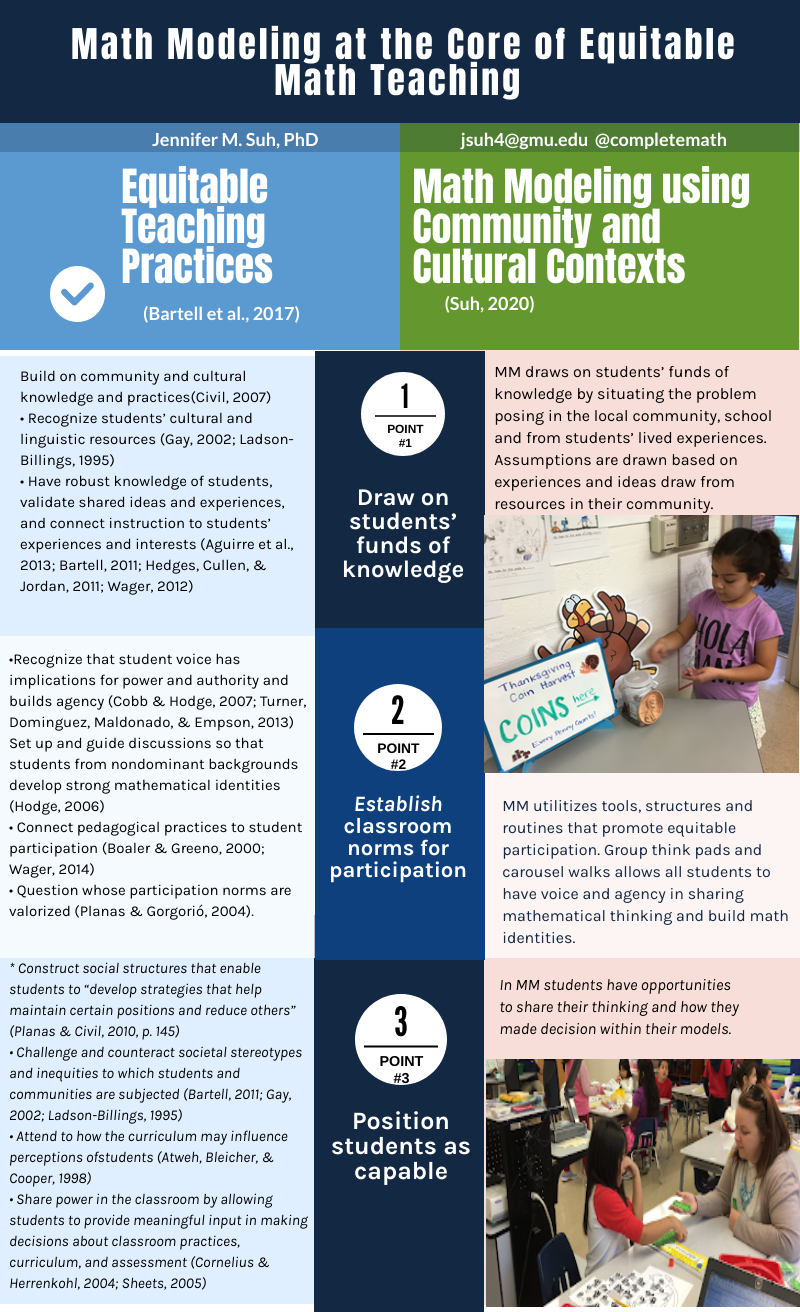Teaching through mathematical modeling within local community contexts in the elementary grades is at the very core of equitable teaching in mathematics. One way to see this connection is to draw upon the framework offered by Bartell et al. (2017) on the research linking equitable teaching with the Standards for Mathematical Practice. Below is the nine important equitable teaching practices (Bartell et al., 2017) and the tenets of math modeling situated in the local community context for early grades mathematics.
Equitable Mathematics Teaching Practices
MM as Equitable teaching.legal paper size
| Equitable Mathematics Teaching Practices (Bartell et al., 2017) | Math Modeling (Suh, 2020) | |
| 1. Draw on
students’ funds of knowledge |
*Build on community and cultural knowledge and practices(Civil, 2007)
• Recognize students’ cultural and linguistic resources (Gay, 2002; Ladson-Billings, 1995) • Have robust knowledge of students, validate shared ideas and experiences, and connect instruction to students’ experiences and interests (Aguirre et al., 2013; Bartell, 2011; Hedges, Cullen, & Jordan, 2011; Wager, 2012) |
MM draws on students’ funds of knowledge by situating the problem posing in the local community, school and students’ lived experiences. Assumptions are drawn based on experiences and ideas draw from resources in their community.
|
| 2. Establish classroom
norms for participation |
•Recognize that student voice has implications for power and authority and builds agency (Cobb & Hodge, 2007; Turner, Dominguez, Maldonado, & Empson, 2013)
Set up and guide discussions so that students from nondominant backgrounds develop strong mathematical identities (Hodge, 2006) • Connect pedagogical practices to student participation (Boaler & Greeno, 2000; Wager, 2014) • Question whose participation norms are valorized (Planas & Gorgorió, 2004) |
MM utilitizes tools, structures and routines that promote equitable participation. Group think pads and carousel walks allows all students to have voice and agency in sharing mathematical thinking and build math identities.
|
| 3. Position students as
capable |
Construct social structures that enable students to “develop strategies that help maintain certain positions and reduce others” (Planas & Civil, 2010, p. 145)
• Challenge and counteract societal stereotypes and inequities to which students and communities are subjected (Bartell, 2011; Gay, 2002; Ladson-Billings, 1995) • Attend to how the curriculum may influence perceptions ofstudents (Atweh, Bleicher, & Cooper, 1998) • Share power in the classroom by allowing students to provide meaningful input in making decisions about classroom practices, curriculum, and assessment (Cornelius & Herrenkohl, 2004; Sheets, 2005) |
In MM students have opportunities to share their thinking and how they made decision within their models.
|
| 4. Monitor how students position each other | Assign competence to support students’ repositioning of one another (Cohen, Lotan, Scarloss, & Arellano, 1999; Featherstone et al., 2011)
• Attend to reification of existing status structures so as to reposition some students with their peers (Forman & Ansell, 2002) • Position students to use one another as mathematical resources (Dunleavy, 2015) |
There is a reporting and refining stage that acknowledges that exchanging differing ideas is part of refining one’s model and advancing their thinking.
|
| 5. Attend explicitly to race and culture | • Make connections to students’ mathematical, racial, and cultural identities (Battey, 2013; Martin, 2007) • Recognize that certain groups have been positioned as antiintellectual (Martin, 2009; Steele, 2003) | MM allows the use of Cultural Sustaining Pedagogy where school becomes a place to sustain one’s cultural identity by sharing community and cultural math happenings . |
| 6. Recognize multiple forms of discourse and language as a resource | • Facilitate respect among students by cultivating culturally responsive relationships among students and validating possible differences in their language practices (Moschkovich, 2013) • Coconstruct resources with students in moment-to-moment interactions around mathematics (Dominguez, 2014) • Consider linguistic choices and acknowledge home language as a valid language of mathematics (Meaney, 2005; Setati, 2005) • Bridge language practices through affirming students’ home languages, modeling code switching, and fostering interactional patterns familiar to students (Brenner, 1998; Howard, 2001; Lee, 1995) |
MM is a rich discursive process that includes students to use multiple representations such as visuals, numbers, words to express one’s mathematical thinking.
|
| 7. Press for academic success | Assess student learning, build on student strengths, explicitly communicate expectations for students, and communicate the teachers’ responsibility in student success (Morrison, Robbins, & Rose, 2008)
• Have high academic expectations while maintaining students’ cultural and psychological well-being rather than accept deficit views about students’ intellectual potential (Fine, 1986; Fordham, 1988) |
MM provides multiple points of assessment for teachers to look for and amplify the strength in student thinking. |
| 8. Attend to students’ mathematical thinking | Recognize, understand, and build from children’s understanding of mathematics (Carpenter, Fennema, Franke, Levi, & Empson, 1999) •
Respond to developmental needs so as not to expect a student to do mathematics they are not developmentally ready for (Jackson, 2009) |
MM has an asset based pedagogy in place to celebrate each students’ contribution and differentiate naturally in the MM process. |
| 9. Support development of a sociopolitical disposition | • Incorporate critical texts, discuss controversial topics, serve the community, and allow social issues to drive instruction (Hickling-Hudson & Ahlquist, 2003; Hyland, 2005; Tate, 1995) • Provide opportunities to explore sociopolitical topics using mathematics (Frankenstein, 2012; Gates & Jorgensen, 2009) • Engage students in conversation about real-world problems and how mathematics can be used to examine them (Gutstein, 2006; Skovsmose, 1994) | Having MM tasks situated within the real world, and the local community and the larger world makes the issues at hand connected to many social issues that can connects how math can be used to make important decisions and eradicate inequities. |



